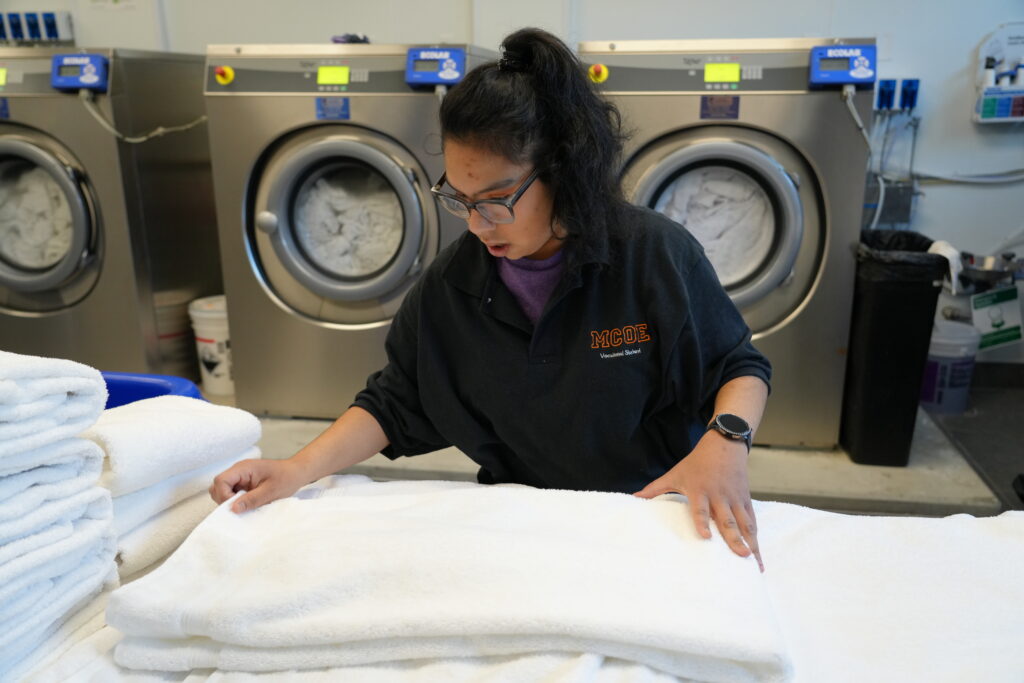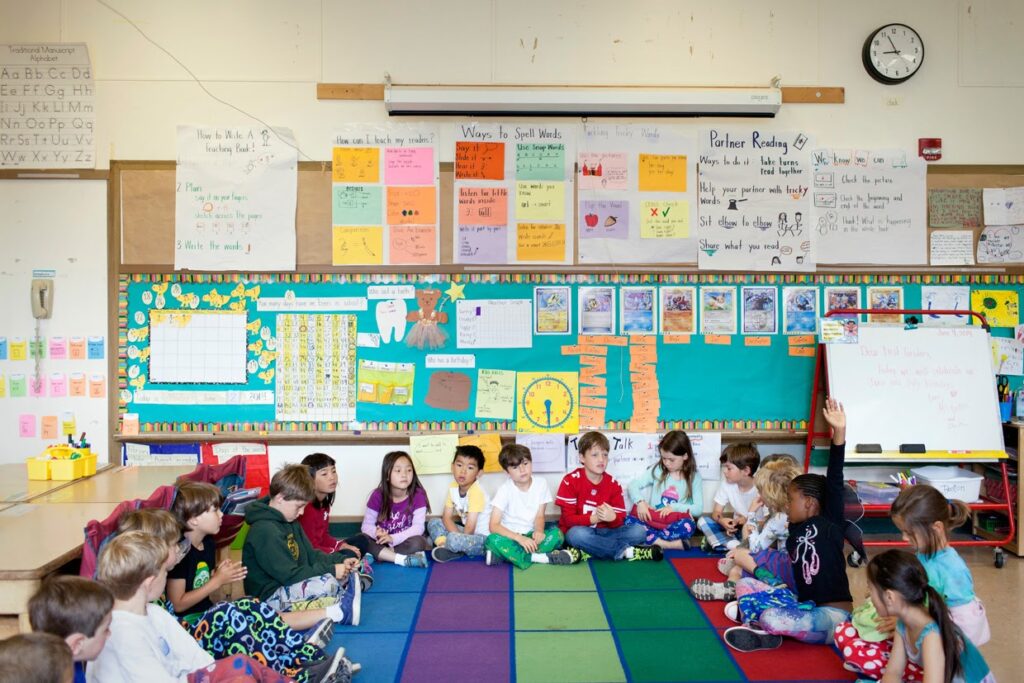
Jeannette, a student in special education in the Merced County Office of Education’s adult transition program, folds El Capitan Hotel towels as part of a housekeeping training program that teaches work and life skills. For student privacy, the county office did not disclose Jeannette’s last name.
Credit: Courtesy of Merced County Office of Education
As guests check out of El Capitan Hotel in downtown Merced, a group of students wearing Merced County Office of Education (MCOE) shirts or lanyards enter recently vacated rooms to strip the beds, empty the trash bins and vacuum the floors.
For more than a year, students like Alondra Fierros, who always has a smile on her face, have separated and washed the hotel’s dirty linens while Jayden Flores has neatly folded the clean hotel towels into stacks of eight without looking up from the task.
Most of the students, ages 18-22, are diagnosed with varying degrees of autism and/or other disabilities, are in special education in the county office’s adult transition program and learning how to do laundry and clean for the first time.
Despite their limits, the students obtain skills as part of the county office and hotel’s housekeeping program.
“I clean the place, and I take a bunch of dirty bed sheets and towels and put them in the laundry room and wash them,” Flores said about tasks he learned by shadowing and observing housekeepers.
Through hands-on experience at the hotel, students gain skills to work in the housekeeping and hospitality industry — whether at El Capitan or elsewhere — after they graduate. And they develop life skills for adulthood.

“At this age, we’re really trying to (give them) more experience in the community,” said Laura Fong, an assistant superintendent in the Merced County Office of Education.
Vocational training programs have traditionally tailored jobs around special education students’ needs, such as a Fresno restaurant with modified cash registers to accommodate students who can’t read.
This is not the case with Merced County’s program which, instead, integrates students into the housekeeping career, making it one of a few in California and across the nation to do so. The program now serves as a model for other districts aspiring to integrate students with disabilities into careers and society.
From model room to real world experience
The office of education launched the housekeeping training program in October 2022 for its special education students to gain work and life skills in a real world setting, Fong said.
Before the program’s creation, students practiced their skills in an “isolated” mock hotel room, which worked for a while, Fong said.
But it wasn’t enough. The students couldn’t apply what they learned to their life because those skills weren’t being used in a real-world environment. They weren’t observing housekeepers’ work, and therefore couldn’t comprehend the logic behind the tasks they were being instructed to do. They weren’t working alongside employees, so they weren’t learning how to interact with others or the proper ways to behave in a work setting.
The county office sought a collaboration with the hotel, which had built the hotel room replica.
Fong said the yearlong program is critical for the students “to be in the actual field,” get on-the-job training and be able to model employees’ behavior, which in turn provides them with real-world experience while allowing them to interact with others.
How county office’s training programs work
Once Merced County special education students finish their shift at a training site, they return to the classroom or visit another training program for the remainder of the day. In class, one of their tasks is to formulate their resume to include their on-the-job training experience.
Working in the actual hotel “really teaches them responsibility,” said vocational trainer Lorie Gonzales, who accompanies the students to their training programs to supervise and assist them, if needed.
With Gonzales checking their uniforms and attire before a shift, students learn that they must dress appropriately for a job. They learn about the importance of being on time because they’re expected at the hotel for their respective shifts and must clock in once they’re there.
Hotel staff are primarily responsible for training students for the housekeeping tasks, said Robin Donovan, managing director of the hotel.
The students remove dirty sheets and linens, vacuum and straighten rooms, so a housekeeper only has to make the bed and clean the bathroom. Once the housekeeper takes over, students sort, wash and dry the laundry, then vacuum the hallways and stairways and wipe down art and other fixtures mounted on the wall.
The work skills, such as changing sheets and cleaning, become independent living skills that students need in their personal lives, Fong said.
“We want them to be prepared. Not only can they go out and find a job in this industry, doing this work, they can also transfer those skills to living on their own, independently,” she said.
Meg Metz, director of people and culture at El Capitan, said the hotel staff were at first worried about how they’d adapt to working with the students. Now, however, the staff looks forward to working alongside students, Metz and Donovan both said.
Donovan added that hotel staff enjoy their shifts with the students who they say are reliable and hardworking and bring positivity to the workplace.
“They do quality work,” she said, “and with the biggest smiles.”
But the social interactions extend beyond connecting with hotel employees. The partnership with the hotel allows students to engage with hotel guests as well, including those who may still be in their rooms.
“When I come to work here in the hotel, I say, ‘Knock, knock. Housekeeping,’” Flores said as he knocked on a third floor hotel room door.
Gonzales, the vocational trainer, has coached the students on being courteous whenever they run into guests in the hallways and stairways. The students, for instance, tell guests to use the elevator first, Gonzales said.
Expanding opportunities for students with special needs
The housekeeping program isn’t the only vocational training program for individuals with disabilities in Merced County or the surrounding Central Valley communities. Since opening in the 1980s, Wired Café has been a coffee shop where adults with disabilities gain skills that prepare them for the workforce, according to Fong. It is owned and operated by Merced County’s education office as well. Students learn and grow as they take orders and fix and serve smoothies, lattes or sandwiches.
Mimicking Wired Café, the Fresno County education office established Kids Café in 2017 as a work-based learning environment for special education students, county office leaders Christina Borges and Liza Stack said.

In their uniforms and aprons, students working at Kids Café complete a variety of tasks, including: preparing and serving food, such as pizza, sandwiches and salads; sweeping or mopping the floors of the restaurant; clearing and wiping the tables after customers leave; stocking inventory; laundering; baking and packaging cookies or scones; weighing and bagging chips; and working the cash register.
The Fresno County office adjusted aspects of the restaurant to accommodate students’ needs and abilities, thereby fostering independence and ensuring student success, Stack said. Restaurant modifications include visual task cards with pictures as well as step-by-step instructions, color-coordinated towels for different cleaning tasks, and a modified register in which 4C means four slices of cheese.
How Kids Café operates
The café provides two-hour shifts for most special education classes during the school year, with longer shifts offered over the summer and winter breaks. Students with special needs living in one of Fresno County’s 30 regional areas for special education services and enrolled in a county-operated program can participate. Participating students may have autism, be deaf or hard of hearing or have emotional disabilities, to name a few. Thirty-three Fresno County special education students, up from 19 last school year, have worked at the restaurant so far this school year.
Starting around July 1, the Fresno County education office will partner with local businesses throughout the county to provide other types of vocational training for students with disabilities and offer employment opportunities in maintenance, facilities and technology at the county office.
“We’re really looking to expand into those areas to give students something more than just restaurant work,” Borges said about integrating students into existing businesses rather than only designing programs for them. “We want to go beyond our students being in one restaurant at one location.”
Much like the Merced County housekeeping training program, Fresno County’s planned expansion would create more vocational training that integrates special education students into careers, rather than tailoring jobs for students — a move that, Borges hopes, will show businesses the value of these students.
Even the California Department of Rehabilitation has worked to close the employment gap for people with disabilities and, in 2022, launched an initiative with the Institute for Workplace Skills & Innovation), a workforce development organization, to employ people with disabilities in allied health care, clerical and manufacturing jobs as part of the Ready, Willing and ABLE program.
In August, the department and organization again partnered to establish Career Launchpad, a vocational skills and career transition program for students with disabilities — an often “overlooked and undervalued” community, a media release at the time said.
Students with disabilities are valuable to the workforce
Overall, vocational training programs such as those in Merced and Fresno exemplify how valuable students with disabilities can be to the workforce, leaders of Merced and Fresno counties said.
“Our students being seen as active, valued members of society is one of the most important things that comes out of this,” Stack said.
Flores, one of the Merced County students, aged out of the housekeeping training program in December when he turned 23. Gonzales, his vocational trainer, said she had hoped his employment with El Capitan Hotel would continue, especially because he could work independently in the training program. The hotel was unable to hire him because they had no open positions. He now participates in the Haven Program, a community-based center serving adults with disabilities.
“I hope in the future, there’s more businesses that will hire them after they graduate,” Gonzales said. “… They’ve proved to us that they are capable.”
As Merced and Fresno counties implement and expand programs throughout their communities, Borges hopes the community’s attitude will change toward students and individuals with disabilities.
“Our students with disabilities,” she said, “have a role in the workforce.”











)




